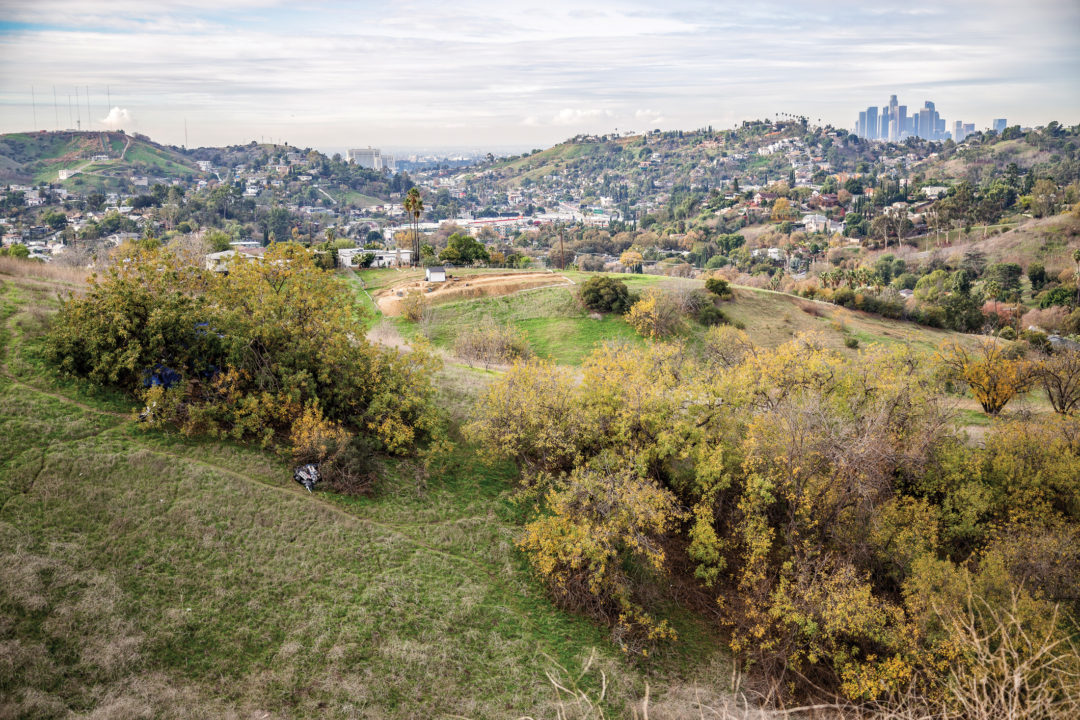A Tree Grows in El Sereno
LA activists are wielding black walnut protections to stop development. Mature black walnut trees are seen in the foreground as one looks south toward downtown Los Angeles from Elephant Hill in El Sereno. Photo: Noé Montes / High Country News.
Mature black walnut trees are seen in the foreground as one looks south toward downtown Los Angeles from Elephant Hill in El Sereno. Photo: Noé Montes / High Country News.
This article was originally published in High Country News.
On May 6, 2022, Adam Baz, a resident who lives near El Sereno, a Northeast Los Angeles neighborhood, noticed a freshly cut pile of black walnut wood on the hillside next to his house. The trees are protected by both local and state ordinances and cannot be cut down without a permit; the one Baz observed had even been inventoried and tagged as part of the site’s Protected Tree Report.
Disturbed by the sight, Baz wrote to the LA Department of Public Works: “There is also a pile of live walnut branches with leaves and fruit. … There can be no mistaking that this tree was alive and healthy prior to being cut down.”
Micah Haserjian, co-founder of Coyotl + Macehualli, a community organization that advocates for the protection of open space native species, including the black walnut, and Jack Smith, a naturalist who works with the nonprofit urban forestry organization TreePeople, visited the site after Baz observed the damage. They found not just one, but 18 recently cut black walnut stumps. “They were just butchered,” said Smith. “Sloppy, aggressive machete cuts.”
Haserjian notified the city, and LA’s Urban Forestry Division investigated the removal of the protected walnuts. Two months later, he received a report stating that only two trees had been taken, and that they were already dead — contradicting the naturalists’ accounts. A representative from the Public Works Department reiterated to High Country News that the two protected trees that were removed were dead and said the evidence “was insufficient to determine the ‘Protected’ status of the (other) numerous stumps.”
The owner of the 4.3-acre open lot, real estate developer Henry Suarez, had been trying to build Onyx-32, a multimillion-dollar housing development, there since 2014. Many in El Sereno—a hilly working-class neighborhood that is about 80% Latino—opposed it. In 2021, after the California Department of Fish and Wildlife wrote a letter recognizing the ecological value of the site’s dozens of black walnut trees, the city’s planning department denied the project. Suarez still owned the land, but he couldn’t build the proposed development on it.
Neighbors speculated that Suarez was responsible for the cutting Baz first reported. When asked for comment by High Country News, Suarez denied any wrongdoing, saying that brush was cleared, as required by the fire department, and that any cut-down trees were already dead. He also claimed that the city had not contacted him about the investigation, though the service request’s log shows that it had communicated with the land owner in mid-June, and the public works department confirmed this.
This conflict over a handful of trees is not an isolated incident. For decades, black walnuts (Juglans californica) were essentially protected from development because they tend to grow on steep hillsides. But in recent years, as LA housing values have soared, it’s become profitable to develop even those accidental refuges. Now, Coyotl + Macehualli is using the tree’s protections to simultaneously achieve several goals: limiting gentrification, fighting extreme heat and deepening the community’s relationship to its ecosystem.
As Haserjian and Contreras knocked on doors to mobilize their community, they learned that other development projects opposed by their neighbors were also home to black walnuts.
Junglans Californica is endemic to Southern California, meaning that it is both native and occurs only there. The trees bloom yellow in the spring. Their walnuts, harvested in early fall, are a food source for the Indigenous Chumash and Tongva peoples, and the husks are used both medicinally and as dyes.
Black walnuts grow in deep, clayey soils on generally north- and east-facing slopes in a band that stretches across Los Angeles County, meaning their habitat includes both working-class neighborhoods like El Sereno and some of LA’s toniest real estate, like Beverly Hills. They anchor a “walnut savannah” ecosystem that nurtures over 29 species of birds as well as coyotes and other mammals. Though the trees are not considered federally endangered or threatened, more than a third of their habitat has been lost to urbanization, and their ecosystem is ranked “sensitive” by the state of California.
In 2019, Haserjian and his partner, Brenda Contreras, learned that a Newport Beach-based developer planned to build seven luxury homes on the hillside behind their home, nearly three miles from the Onyx site. Despite the property’s multiple black walnut trees, the project had been exempted from state environmental review. When Haserjian and Contreras read the biological report commissioned by the developer, they were alarmed to see it claimed the site had “no sensitive plant communities” and “did not contain suitable habitat” for black walnuts.
They decided to fight. They initiated a lawsuit over the absent environmental review and their lawyer hired a biologist to write another report, which identified a dozen live walnuts on the site, as well as a three-foot-wide stump that had been a living tree in 2017, according to images on Google Earth. There was no mention of a permit for its cutting.
As Haserjian and Contreras knocked on doors to mobilize their community, they learned that other development projects opposed by their neighbors were also home to black walnuts. That included the Onyx-32 development, as well as another project called Vista El Sereno, which was allowed to forgo a full environmental review despite having over 100 black walnuts. They incorporated Coyotl + Macehualli and sued the city of LA.
Forestry projects target neighborhoods that lack shade, which often have many low-income residents and residents of color.
Realizing that the walnuts were more than a tool for litigation, they organized Coyotl + Macehualli community events, such as nature walks and “guerrilla gardening” projects where they planted black walnuts in the nearby hills. Next to the Vista El Sereno site, which is near an elementary school and a bus stop, they planted buckwheat, white sage, black sage and mountain mahogany. At Sunday coffee hours, they spoke with neighbors about the hillside and its habitat.
Today, Coyotl + Macehualli counts around 100 members. In the Indigenous Nahuatl language, coyotl can mean “coyote,” while macehualli translates to “Indigenous person,” said Contreras. They chose the name to signal their alignment with Indigenous values and a “horizontal relationship between us humans and our animal relatives.”
Wealthy communities have also used environmental protections to fight development, especially in California. But Coyotl + Macehualli’s work is fundamentally different, its members say: For one thing, many of them are renters, who want to protect the ecosystem, not their property values. For another, the neighborhood has less tree canopy than most of LA, making trees increasingly important as the weather gets hotter.
José “Gama” Gama Vargas, who works for an urban forestry nonprofit, said he joined Coyotl + Macehualli because he saw the value of the group’s “adversarial” approach—suing the city—as a complement to that work. Forestry projects target neighborhoods that lack shade, which often have many low-income residents and residents of color, he said, but gentrification often happens faster in those areas than grant-writing, permitting and ecological restoration can keep up with.
“By the time we start doing the project, it feels like half the community is already gone. We’re planting trees for wealthier people,” he said. “The best way to have canopy is to keep the large trees that we have.”
Coyotl + Macehualli’s lawsuits are having an effect. In November, the judge in the Vista El Sereno case ruled in the group’s favor, which means the developer, True Life Companies, will be required to submit an environmental impact report. (Asked for comment, Aidan Barry of True Life said that the company was disappointed by the decision, noting that it had planned to replace the walnuts.) But in the case involving the hillside behind Haserjian and Contreras’ house, the judge upheld the environmental review exemption on the grounds that black walnuts were not sufficiently threatened. That case is not over; the judge is requiring additional briefs regarding the project’s air quality and noise impacts.
As the court makes its decision, Coyotl + Macehualli’s work continues with hikes, walnut propagation, and more gardening. “There’s going to be conflict,” said Gama Vargas. “But with it, there’s going to be resolution and learning. I do feel we can create an approach to protecting our ecosystem where nobody is left out. People say plants are teachers — but the black walnut is an organizer.”
Your support matters…Independent journalism is under threat and overshadowed by heavily funded mainstream media.
You can help level the playing field. Become a member.
Your tax-deductible contribution keeps us digging beneath the headlines to give you thought-provoking, investigative reporting and analysis that unearths what's really happening- without compromise.
Give today to support our courageous, independent journalists.








You need to be a supporter to comment.
There are currently no responses to this article.
Be the first to respond.